| |
Entecavir Improved Fibrosis in Advanced Liver Disease More Than Lamivudine in 3 Pivotol Studies After 48 Weeks Therapy
|
| |
| |
Reported by Jules Levin
EASL April 26-30, 2006, Vienna, Austria
"Effects of Entecavir (ETV) and Lamivudine (LVD) on Advanced Liver Fibrosis after 48 Weeks of Treatment in Patients with Chronic Hepatitis B (CHB) Infection: Results of Three Pivotal
Trials"
H. Simsek1, E. Schiff2, Z. Goodman3, H. Brett-Smith4, K. Klesczewski4, B. Kreter4 1Department of Internal Medicine, Hacettepe University Medical School, Ankara, Turkey; 2Center for Liver Diseases, University of Miami School of Medicine, Miami, USA; 3Department of Hepatic and Gastrointestinal Pathology, Armed Forces Institute of Pathology, Washington, DC, USA; 4Bristol-Myers Squibb Company, Wallingford, CT, USA
Author Conclusions:
Improvement in fibrosis among patients with advanced liver fibrosis/cirrhosis supports use of ETV in these patients.
Among patients with advanced liver fibrosis/cirrhosis, higher proportions of ETV- compared to LVD-treated patients were observed to have improvement or no change in Ishak fibrosis.
- 43% of ETV-treated, LVD-ref patients with advanced liver fibrosis/cirrhosis had improvement in Ishak fibrosis score (33% for lamivudine)
- Among LVD-ref patients with advanced liver fibrosis/cirrhosis, observed proportions of patients with improvement or no change in Ishak fibrosis were higher among ETV-treated patients compared to LVD-treated
Efficacy of ETV in LVD-Refractory Patients with Advanced
Liver Fibrosis/Cirrhosis
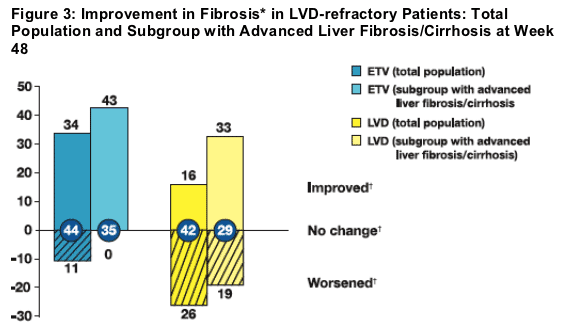
SEE ADDITIONAL GRAPHS FOR OTHER STUDY POPULATIONS BELOW.
Introduction: Fibrosis & Cirrhosis Can Be Reversed with Successful Antiviral Therapy
- Fibrosis and cirrhosis are well-recognized complications of chronic hepatitis B (CHB) infection
- Until recently, liver fibrosis and cirrhosis have generally been considered to be irreversible. However, advances in the treatment of liver diseases have shown that therapeutic interventions have been associated with histologic improvement, including regression of fibrosis1,2
- Recent studies have shown that antiviral therapy can reduce disease progression in CHB patients with advanced liver fibrosis/cirrhosis3,4
- Entecavir (ETV) is an antiviral approved for treatment of CHB. Several studies have shown ETV to be superior to lamivudine (LVD) in improving histology,
virologic and biochemical endpoints in compensated patients with CHB5-7
Study Objective
- In the Phase III CHB patient population, a subset of patients had advanced liver fibrosis/cirrhosis
- This is a descriptive subgroup analysis to assess Week 48 treatment responses in patients with biopsy-proven advanced liver fibrosis/cirrhosis at baseline (Ishak score of 4-6)
Abstract
Background: Entecavir (ETV) was superior to lamivudine (LVD) in achieving histologic improvement, ALT normalization and HBV DNA suppression at Week
48 in Phase III trials. Improvement in fibrosis was similar between treatments in nucleoside-naive patients and superior in ETV treated LVD-refractory patients. This evaluation examined the impact of 48 weeks of ETV or LVD treatment in patients with advanced liver fibrosis/cirrhosis (Ishak score: 4-6).
Methods: Fibrosis was evaluated at baseline and at Week 48 by a central histopathologist blinded to treatment and to the sequence of samples. A subset analysis was performed for those patients having advanced liver fibrosis/cirrhosis
at baseline (Ishak score of 4-6).
Results: Results are summarized in the table below:
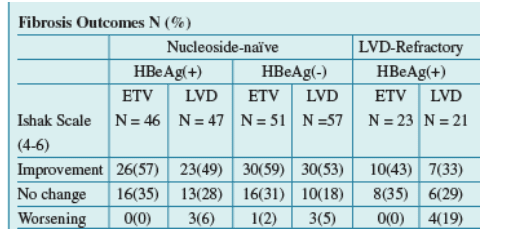
For nucleoside naive patients: Mean baseline HBV DNA was 8.83 to 9.14 log 10 copies/ml for HBeAg+ patients with advanced fibrosis/cirrhosis, and 7.80-7.86 for HBeAg(-) patients w advanced liver disease, and mean ALT was 183 to 202 for HBeAg+ and 156-150 for HBeAg(-). For lamivudine refractory mean HBV-DNA was 8.8 to 9.7 log cp/ml, and ALT was 139.
Conclusions: Patients with advanced liver fibrosis/cirrhosis who received ETV were more likely to experience either improvement or no change in the
appearance of their biopsy than LVD-treated patients. These data are consistent with other treatment endpoints (virologic, biochemical and overall histologic improvement by Knodell from the overall study population) which demonstrated superiority of ETV over LVD.
Key Study Endpoints
- Primary
- Histologic Improvement: >/= 2 point improvement in Knodell Necroinflammatory Score with no worsening of Knodell fibrosis score at Week 48
- Secondary
- Proportion of patients with HBV DNA <300 copies/mL by Roche COBAS Amplicor■ PCR
- ALT normalization (

LVD-ref=lamivudine refractory. Advanced Liver Fibrosis defined as Ishak score of 4-6.
Selected Criteria for Enrollment in Phase III ETV
Clinical Trials
- HBV DNA >3 MEq/mL (HBeAg+) or >0.7 MEq/mL (HBeAg-) by bDNA assay
- ALT 1.3-10 x ULN
- Compensated liver function
- Total serum bilirubin <2.5 mg/dL
- Prothrombin time ≦3 sec or INR <1.5
- Serum albumin >3.0 g/dL
- No history of variceal bleed or hepatic encephalopathy
- Alpha-fetoprotein <100 ng/mL
- No HCV, HDV, HIV coinfection
Efficacy of ETV in LVD-Refractory Patients
(total population)
Switching to ETV provided superior histologic improvement, ALT normalization and undetectable HBV DNA (<300 copies/mL) than continuing LVD in LVDrefractory HBeAg(+) CHB patients
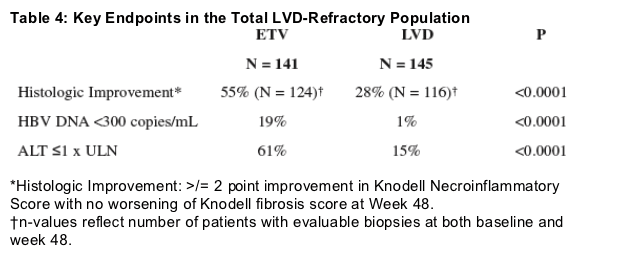
*Histologic Improvement: >/= 2 point improvement in Knodell Necroinflammatory Score with no worsening of Knodell fibrosis score at Week 48.
n-values reflect number of patients with evaluable biopsies at both baseline and week 48.
Efficacy of ETV in Nucleoside-Naive Patients with
Advanced Liver Fibrosis/Cirrhosis
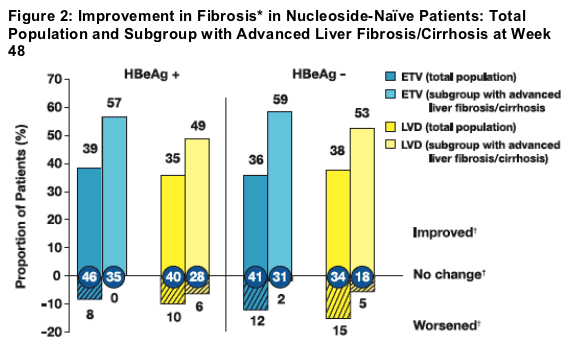
- 57% HBeAg(+) and 59% of HBeAg(-) of ETV-treated patients with advanced liver fibrosis/cirrhosis had improvement in Ishak fibrosis score
- Among patients with advanced liver fibrosis/cirrhosis, observed proportions of patients with improvement or no change in Ishak fibrosis were higher among ETV-treated patients compared to LVD-treated in both HBeAg(+) and HBeAg(-) populations
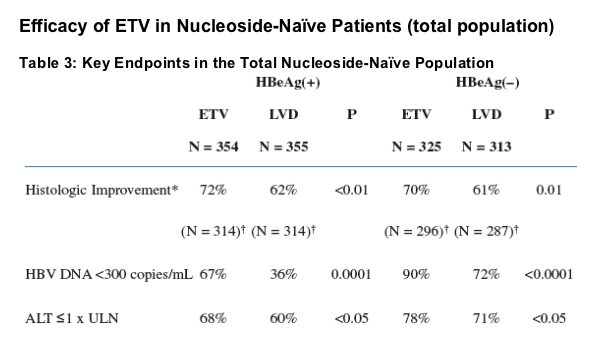
*Histologic Improvement: >/= 2 point improvement in Knodell Necroinflammatory Score with no worsening of Knodell fibrosis score at Week 48.
n-values reflect number of patients with evaluable biopsies at both baseline and
week 48.
|
|
| |
| |
|
|
|